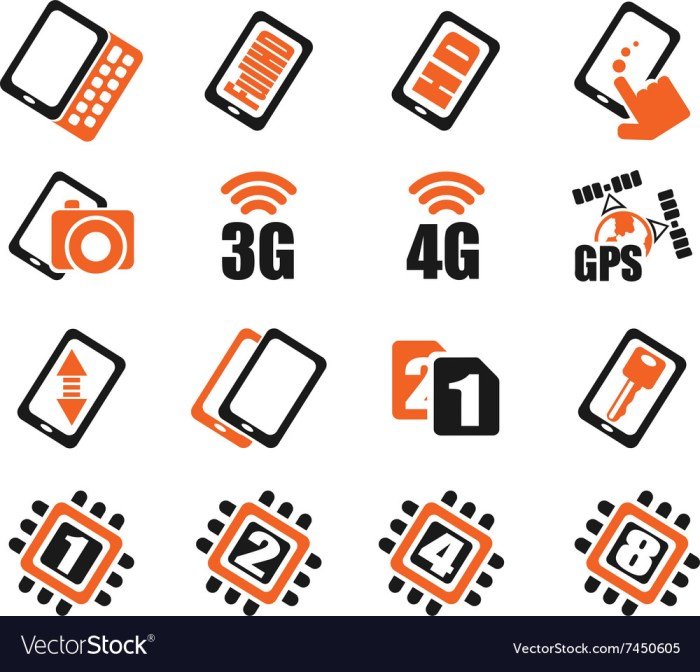Smartphone hardware specs: the unsung heroes behind your seamless digital life. From lightning-fast processors to vibrant displays and long-lasting batteries, every component plays a crucial role in shaping your mobile experience. This comprehensive guide dives deep into the heart of your smartphone, revealing the intricate technologies and innovations that make it all possible. Get ready to unlock a new level of understanding and appreciation for the device that’s always in your pocket.
We’ll explore the critical components that define a smartphone’s performance. Discover how the CPU’s core count and clock speed influence your gaming and multitasking capabilities, and learn about the different GPU manufacturers and their strengths in graphical prowess. Understand the significance of RAM in handling apps and the impact of storage technology on overall responsiveness. Uncover the secrets of display technology, from OLED to refresh rates, and explore the magic behind camera systems, including megapixels, aperture, and image stabilization.
Delve into the factors that influence battery life and fast-charging technologies, explore the connectivity options that keep you connected, and discover the world of sensors that enhance user interaction.
Unveiling the Power Within: Smartphone Hardware Specs
Smartphones have become indispensable tools, and their performance hinges on the intricate hardware that powers them. Understanding these components is key to making informed decisions when choosing a device and appreciating the technological marvel in your pocket. This article delves into the core specifications that define a smartphone’s capabilities, from the processing power to the display clarity, offering a comprehensive guide to the inner workings of your mobile companion.
Central Processing Unit (CPU)

Source: vectorstock.com
The CPU, or Central Processing Unit, is the brain of your smartphone, responsible for executing instructions and managing all operations. Its performance directly impacts the speed and responsiveness of your device.
- Core Count and Clock Speed: The number of cores and clock speed are primary determinants of CPU performance. More cores allow the CPU to handle multiple tasks simultaneously (multitasking) more efficiently. Clock speed, measured in GHz, indicates how quickly each core can process instructions. A higher clock speed generally translates to faster processing for single-threaded tasks. However, modern CPUs often employ a combination of both, with some cores optimized for efficiency and others for peak performance.
- CPU Architectures: The architecture of a CPU determines its fundamental design and how it executes instructions.
- ARM: ARM is the dominant architecture in smartphones. Known for its energy efficiency, it powers most Android and iOS devices. Advantages include a wide range of licensees, optimized designs for mobile, and a strong ecosystem of software and hardware support.
- x86 (Intel/AMD): While less common in smartphones, x86 architectures are found in some high-end devices and are prevalent in PCs. They offer powerful processing capabilities but can be less energy-efficient than ARM.
- Thermal Throttling: CPUs generate heat during operation. When the temperature exceeds a certain threshold, thermal throttling kicks in, reducing the clock speed to prevent overheating. This can lead to performance dips, especially during intensive tasks like gaming or video editing. Advanced cooling solutions, such as heat pipes, are used in some smartphones to mitigate this effect.
- CPU in Action: The CPU is crucial for various tasks. In gaming, it handles game logic, physics calculations, and AI. For video editing, it processes video encoding and decoding. During multitasking, it manages the execution of multiple apps simultaneously.
Graphics Processing Unit (GPU), Smartphone hardware specs
The GPU, or Graphics Processing Unit, is dedicated to handling graphics-related tasks, playing a crucial role in gaming, video playback, and the overall visual experience on your smartphone.
- GPU and Graphical Performance: The GPU directly impacts the smoothness and visual fidelity of games and applications. A powerful GPU can render complex graphics with higher frame rates, resulting in a more immersive and responsive experience.
- GPU Manufacturers:
Manufacturer Strengths Examples Key Features ARM (Mali) Energy efficiency, integrated solutions Mali-G7xx series Advanced shading, support for Vulkan and OpenGL ES Qualcomm (Adreno) High performance, integration with Snapdragon SoCs Adreno 7xx series Ray tracing, variable rate shading, AI acceleration Imagination Technologies (PowerVR) Strong graphics performance, innovative architectures PowerVR GT series Tile-based rendering, efficient power usage - Modern GPU Technologies: Modern GPUs employ advanced technologies to enhance graphics quality.
- Ray Tracing: Simulates the way light behaves in the real world, creating realistic reflections, shadows, and lighting effects.
- Variable Rate Shading (VRS): Allows the GPU to prioritize rendering quality in areas of the screen where it is most noticeable, optimizing performance.
- AI Acceleration: Integrated AI capabilities enhance image processing, game performance, and other tasks.
- GPU Benchmarking: GPU performance is measured using benchmarks like 3DMark, GFXBench, and others. These tests simulate various graphics-intensive scenarios and provide scores that allow for comparisons between different GPUs.
Ultimate Conclusion
In conclusion, understanding smartphone hardware specs empowers you to make informed decisions, optimize your device’s performance, and appreciate the technological marvel in your hands. From CPU and GPU to RAM, storage, display, camera, battery, connectivity, and sensors, each component contributes to the overall experience. Now you’re equipped to navigate the ever-evolving landscape of smartphone technology and choose the perfect device to match your needs and desires.
Embrace the power of knowledge and take control of your digital world.
